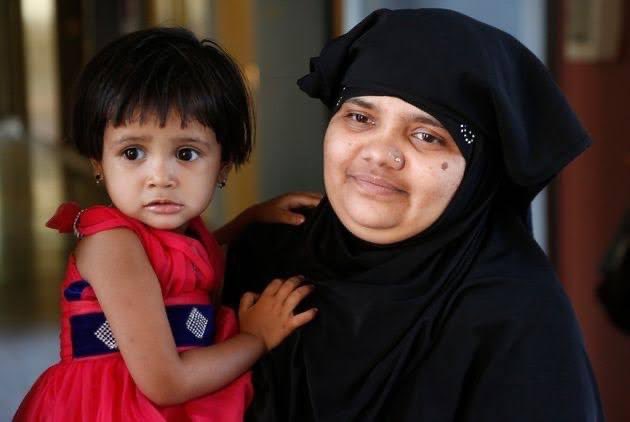On Monday when Bilkis Bano watched the news in Gujarat’s Devgadh Baria in Dahod, she went numb; it seemed like opportunity arrived to a stop. The news had broken that the 11 men, who had been condemned to life detainment for assaulting her and killing her relatives during the 2002 Gujarat riots, had been let out of Godhra sub-prison after a board set up by the Gujarat government supported their application for reduction of the sentence.
Her better half, Yakub Rasool, was cited as telling Indian Express, “We have been left numb, stunned and shaken. The fight we battled for such countless years has been enveloped with one second. A sentence of life detainment given by the court has been reduced in such a way… We had never at any point known about the word ‘reduction’. We didn’t actually realize that such a cycle exists.”
The revulsions have possibly compounded for Bilkis as the convicts when left prison, were invited with desserts and laurels outside the prison. Radheshyam Shah, the convict whose supplication for untimely delivery prepared for all the 11 life sentence convicts to leave prison, said he felt glad to be delivered.
“The Gujarat government has delivered us according to the request for the Supreme Court. I feel delighted to be out as I will actually want to meet my relatives and start another life,” he said.
The matter immediately swelled into a political fight with the Opposition over the arrival of the convicts.
As the issue snowballs into a political line, this is what has been going on with Bilkis Bano? What was her difficult experience from equity’s point of view? We separate the matter.
What is the Bilkis Bano case?
Gujarat had turned rough after the Sabarmati train was singed in Godhra on 27 February 2002. 59 karsevaks were killed in the train.
Dreading the episode of viciousness, a then five-month pregnant Bilkis Bano escaped from Randhikpur, her town, with her three-and-a-half-year-old girl and 15 other relatives.
They took shelter in the Chhaparvad area. Be that as it may, on 3 March, they were gone after by around 20-30 individuals furnished with sickles, blades, and sticks. Among the assailants were the 11 denounced men.
Bilkis, her mom, and three different ladies were assaulted and ruthlessly attacked. Of the 17-part gathering of Muslims from Radhikpur town, eight were found dead, six were absent. Just Bilkis, a man, and a three-year-old endure the assault.
According to numerous reports, Bilkis recaptured cognizance three hours after the occurrence and in the wake of getting garments from an adivasi lady advanced toward the Limkheda police headquarters to enlist an objection.
Bilkis was taken to a public emergency clinic for clinical assessment solely after she arrived at the Godhra help camp. Her case was taken up by the National Human Rights Commission (NHRC) and Supreme Court, which requested an examination by the CBI.
What occurred for the situation?
The denounced for the situation were captured in 2004 and the preliminary started in Ahmedabad. Notwithstanding, after Bilkis communicated anxieties that witnesses could be hurt and the proof gathered by the CBI altered, the zenith court moved the case to Mumbai.
On 21 January 2008, the Special CBI Court condemned 11 blamed to life detainment on the charges of scheming to assault a pregnant lady, murder and unlawful gathering under the Indian Penal Code. The court absolved seven other blamed for need for proof. One of the blamed had kicked the bucket during the preliminary.
The court held that Jaswantbhai Nai, Govindbhai Nai, and Naresh Kumar Mordhiya (perished) had assaulted Bilkis, while Shailesh Bhatt had murdered her little girl, Saleha, by “crushing” her on the ground.
Other people who were indicted are Radheshyam Shah, Bipin Chandra Joshi, Kesarbhai Vohania, Pradeep Vohania, Bakabhai Vohania, Rajubhai Soni, Nitesh Bhatt, Ramesh Chandana, and Head Constable Somabhai Gori.
As per The Indian Express, Judge Salvi named Bilkis’ “gutsy testimony as the defining moment for the situation.”
Right around 10 years after this, the Bombay High Court, in May 2017, maintained the conviction and life detainment of 11 individuals in the assault case.
In 2019, the Supreme Court granted pay of Rs 50 lakh to Bilkis — the primary such request for a situation connected with the 2002 mobs. “It is extremely evident that what shouldn’t have happened has occurred and the state needs to give remuneration,” the pinnacle court seat of the then Chief Justice of India Ranjan Gogoi, and Justices Deepak Gupta and Sanjiv Khanna, had said.
Why release the convicts?
One of the convicts, Radheshyam Shah, had moved toward the Gujarat High Court looking for reduction of the sentence under segments 432 and 433 of the Code of Criminal Procedure. The high court excused his supplication while seeing that the “proper government” to take a choice about his reduction is Maharashtra, and not Gujarat.
Shah then documented a request in the Supreme Court, arguing that he had been in prison for a very long time and four months without reduction starting around 1 April 2022.
The pinnacle court guided the Gujarat government to investigate the issue of reduction of his sentence following which the public authority framed a panel, said Panchmahal Collector Sujal Mayatra, who headed the board.
“A board shaped a couple of months back took a consistent ruling for reduction of the relative multitude of 11 convicts for the situation. The proposal was shipped off the state government, and yesterday we got the orders for their delivery,” said Mayatra.
The 11 convicts in the Bilkis Bano case on Monday left Godhra sub-prison.
Safeguarding the choice, Gujarat Additional Chief Secretary, Home, Raj Kumar, was cited as telling news organization PTI that the Supreme Court had requested that the public authority consider early arrival of these 11 convicts under the state’s reduction strategy which was active when they were articulated blameworthy for the situation by the preliminary court.
“These 11 people were sentenced by an exceptional court in Mumbai in 2008. At the hour of conviction, Gujarat was following a reduction strategy which became effective in 1992. At the point when the matter arrived at the Supreme Court, it guided us to make a choice about the delivery under the 1992 strategy, since that was predominant when conviction came in 2008,” Kumar told PTI.
Gujarat embraced a new and reexamined reduction strategy for detainees in 2014. In that strategy, which is as of now active, there are definite rules about classifications of convicts who can or can’t be given help, said the senior administrator.
“Since the conviction occurred in 2008, the SC guided us to consider this case under the 1992 strategy, which was active in 2008. That approach had no particular lucidity concerning who can be given abatement and who can’t. That approach was not that point by point in contrast with the 2014 arrangement,” said the IAS official.


